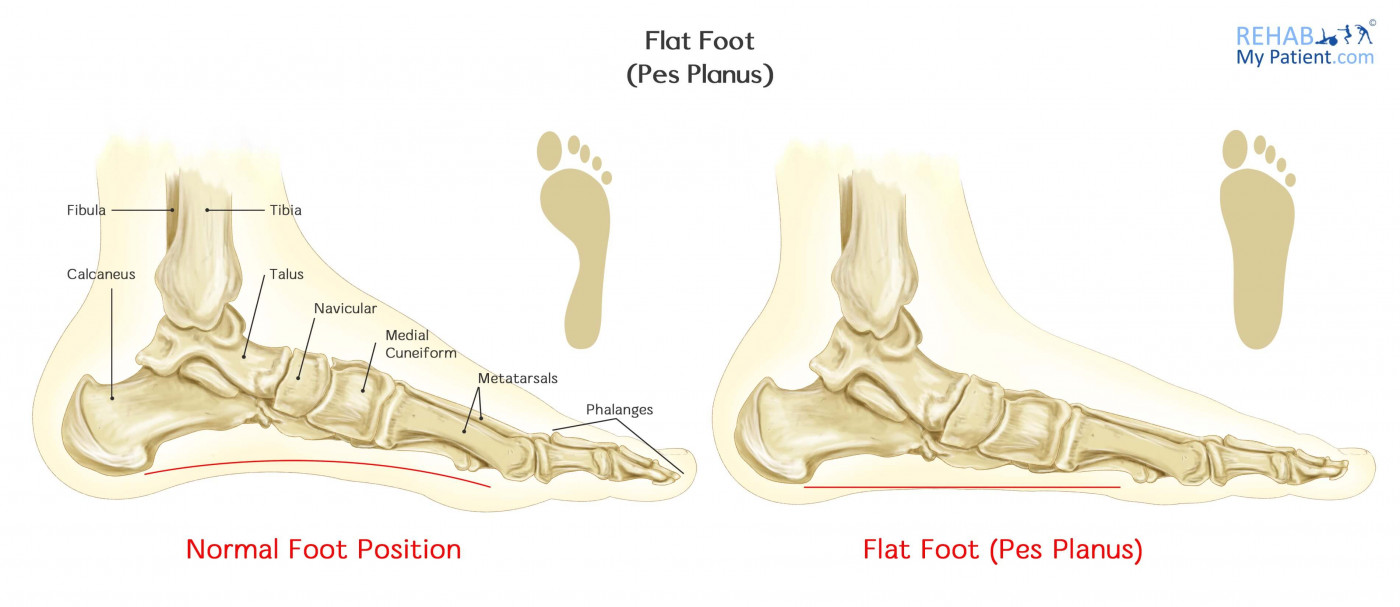
Flat foot, sometimes known under the medical term pes planus, is when the arch along the inside of your foot is flattened, which allows the entire sole of the foot to touch against the floor when standing. Even though the condition is fairly common, it’s often not painful although some experts believe it can lead to other problems.
Pes planus can occur when the arches don’t properly develop during childhood. However, in many populations in the world flat feet is perfectly normal, for example in some African population groups. Sometimes pes planus can also occur through degenerative changes and weakness to the muscular and ligament structure on the inside arch. So if this support structure is compromised through injury or wear and tear, the medial (inside) arch can drop causing a flat foot.
The arches in the feet are designed to help absorb and transmit ground reaction force. Like an arch of a bridge, the arch tends to be very strong. A flat foot can often attribute to problems within the ankles and knees since the condition can end up altering the ideal alignment of the legs, and hence affecting the force transmission through the lower limb. If you don’t experience pain, treatment is often not required for the condition.
Flat Foot Anatomy
Flat foot tends to be common in toddlers and infants because the arch in the foot hasn’t yet developed. Most of the time, the arches in feet will develop throughout childhood, but there are some individuals who don’t ever develop arches. This tends to be a normal variation within the type of foot the individual has. People who don’t have any arches might not have any problems.
Over the course of time, arches can end up falling. Years of wear-and-tear can cause the tendon running along the inside of the ankle supporting the arch to become weak.

How to Treat Flat Foot:
Expert view differs on whether a flat foot should be treated. As a general rule of thumb, if the arch is flat from childhood or due to the population group of the patient, the foot is usually left alone without intervention unless it is deemed to be causing a major issue in the ankle, knee or hip. However an acquired flat foot may be treated with the intention to improve or increase support to the arch, helping to restore normal biomechanics to the foot.
There is also a debate about appropriate footwear, especially for runners. Some experts believe that a good quality running shoe with arch support, or an anti-pronation running shoe helps to support the medial arch to reduce foot problems. However, some experts believe that running in a barefoot shoe such as Vibram’s Five Fingers is more natural to the human body, and would be closer to what our ancestors would have worn when wondering plains. Whatever you decide, talk to an expert or a sports coach about the pro’s and con’s of both.
- Arch Supports
Over-the-counter arch supports can help to relieve the pain associated with flat foot. The doctor or therapist might also suggest that you utilize custom-designed supports, which are molded to fit the contours of your feet. Custom designs are often made by using a foam box which allows the shape of the foot to be recorded in a 3D pattern, or a ground reaction force plate which measure foot contact with the ground, timing, and force going into various parts of the foot. Arch supports may or may not cure the flat foot, but they can help to reduce symptoms.
- Stretching Exercises
Some individuals who have flat foot also end up having a shortened Achilles tendon. Exercises to help stretch out this tendon can prove beneficial. Your therapist will guide you on the best exercises to do.
- Strengthening Exercises
Increasing the strength of the intrinsic foot muscles can have a significant effect on the quality of the medial arch. Exercises such as walking on the outside of your feet for a required length of time, heel raises, ball squeezes with your sole can help to strengthen the muscles and ligaments. Your therapist will advise you the correct exercises.
- Proper Footwear
Structurally supportive shoes might be better for the feet than that of shoes with only a minimal amount of support or sandals. Some people find wearing a shoe with a small heel also provides added support to the arch.
- Surgery
Surgery isn’t performed just for correcting the flat foot condition. Surgery might end up being performed due to an associated problem such as a rupture or tear in the Achilles tendon, or to clean up arthritis.
Tips:
- Avoid engaging in any activities that aggravate the condition and make it worse. Try participating in low-impact activities, such as biking, walking or swimming, instead of that of running and jumping.
- Try an over-the-counter arch support to help alleviate some of the pain and pressure that you are currently feeling in your feet. Only use it short term to start with, under the guidance of your therapist.
- To help overcome the pain and discomfort, you might want to use a pain medication from over-the-counter.
- For those who are overweight, losing weight can help to reduce the amount of stress that you are currently placing on your feet. The more in line you are with your ideal weight, the better it will be for your condition.
- As you grow older, the chance for the tendon to weaken in the foot tends to increase, which only leads to more instances of flat foot.
- A traumatic injury to the ankle or foot can wind up leaving you with flat foot which can develop over several years.
Sign UP
Sign up for your free trial now!
Get started with Rehab My Patient today and revolutionize your exercise prescription process for effective rehabilitation.
Start Your 14-Day Free Trial